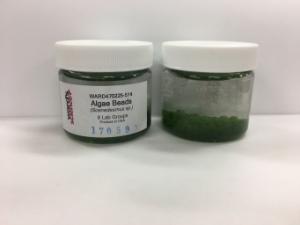Explore pH Effects with Algae Bead Bracelets
All Grade Levels
Metabolic processes, including photosynthesis and respiration, are fundamental to life on Earth. Your lesson plans can help students understand the relationship between these processes and the pH changes due to sunlight exposure. They’ll be fascinated to learn how organisms regulate their internal pH levels when exposed to sunlight. These concepts shed light on the fascinating workings of life and have practical applications in fields such as agriculture and environmental science.
What are metabolic processes?
Metabolic processes, the chemical reactions that sustain life, are indispensable for all living organisms. Two of the most crucial metabolic processes are photosynthesis and respiration. Photosynthesis, which occurs primarily in plants, algae, and some bacteria, is the process by which organisms convert sunlight into chemical energy in the form of glucose. On the other hand, respiration is how organisms release this stored energy by breaking down glucose, typically using oxygen.
How does pH level impact metabolism?
The pH level, a measure of the acidity or alkalinity of a solution, plays a vital role in metabolic processes. The pH of a cell's environment can impact the activity of enzymes, the efficiency of metabolic reactions, and, ultimately, an organism's ability to thrive. Students will enjoy exploring the intriguing interplay between pH levels and metabolic processes, particularly the changes that occur in response to sunlight exposure.
Photosynthesis and pH:
Photosynthesis is a complex biochemical process in the chloroplasts of plant cells, where chlorophyll captures sunlight and converts it into chemical energy. Plants really enjoy a light snack! One intriguing aspect of photosynthesis is its impact on pH levels within the cell.
During photosynthesis, carbon dioxide (CO2) is absorbed from the atmosphere, and water (H2O) is taken up through the plant's roots. These molecules are used to produce glucose (C6H12O6) and oxygen (O2) while releasing protons (H+) in the process. The release of protons makes the cellular environment more acidic, leading to a decrease in pH. This drop in pH is generally compensated for by various cellular mechanisms to maintain an optimal pH for enzyme activity.
Respiration and pH:
Respiration, the process by which organisms release stored energy from glucose, also influences cell pH levels. In respiration, glucose is oxidized to produce carbon dioxide (CO2), water (H2O), and energy. This process consumes oxygen (O2) and releases protons (H+).
Unlike photosynthesis, respiration tends to increase cellular acidity, leading to a rise in pH. Cells have regulatory mechanisms, such as the bicarbonate buffering system, to prevent excessive pH changes during respiration. This buffering system helps maintain pH homeostasis, ensuring the optimal functioning of enzymes involved in respiration.
Sunlight Exposure and pH Changes:
Exposure to sunlight can influence cell pH levels, primarily due to the dynamics of photosynthesis and respiration. Photosynthesis dominates when plants are exposed to sunlight, decreasing pH as protons are released. Conversely, during periods of darkness or reduced sunlight, respiration becomes more dominant, increasing pH as protons are consumed.
This fluctuation in pH can have significant implications for organisms' metabolic processes and ecosystems. For instance, it can affect nutrient availability, enzyme activity, and overall growth and productivity of plants.1 Additionally, changes in pH due to sunlight exposure can impact aquatic ecosystems by affecting the pH levels of water bodies, which, in turn, affect the health of aquatic organisms.
Understanding the relationship between metabolic processes, sunlight exposure, and pH changes helps students explore the connections between biology and environmental science when discussing photosynthesis and respiration. They’ll realize how pH changes due to sunlight exposure can have broader ecological implications. After a while, your lessons will totally grow on them!
Hands-On Activity
Download the Make Your Own Algae Bead Bracelet activity to engage students in a demonstration that shows the impact of pH changes on enzyme activity and metabolic processes. This practical activity can enhance students' understanding of key concepts in your lesson plan.
1. U.S. EPA: Causal Analysis/Diagnosis Decision Information System (CADDIS): pH
Recommended Products
[StartProductBlock]
Ward's® Algae Beads
Demonstrate photosynthesis and respiration in action with our ready-made algae beads.
[EndProductBlock]
[StartProductBlock]

Bicarbonate Indicator
500 mL.
[EndProductBlock]
[StartProductBlock]

Plastic Vinyl Tubing
Vinyl Tubing 1/4" ID for connectors.
[EndProductBlock]
